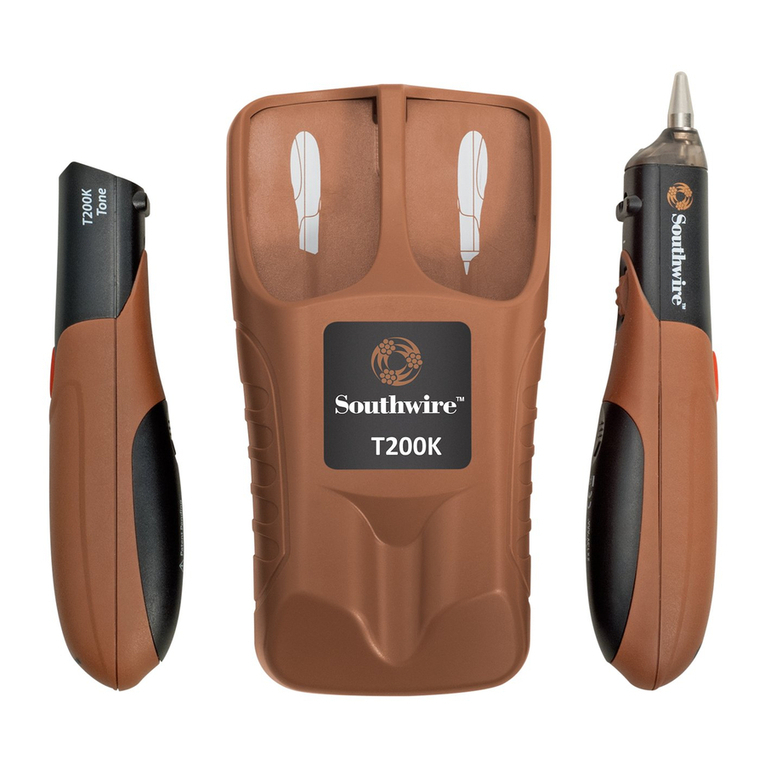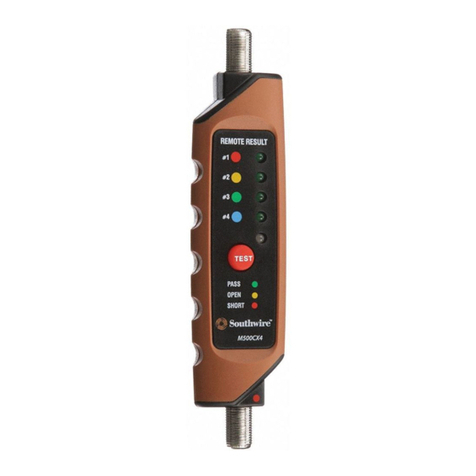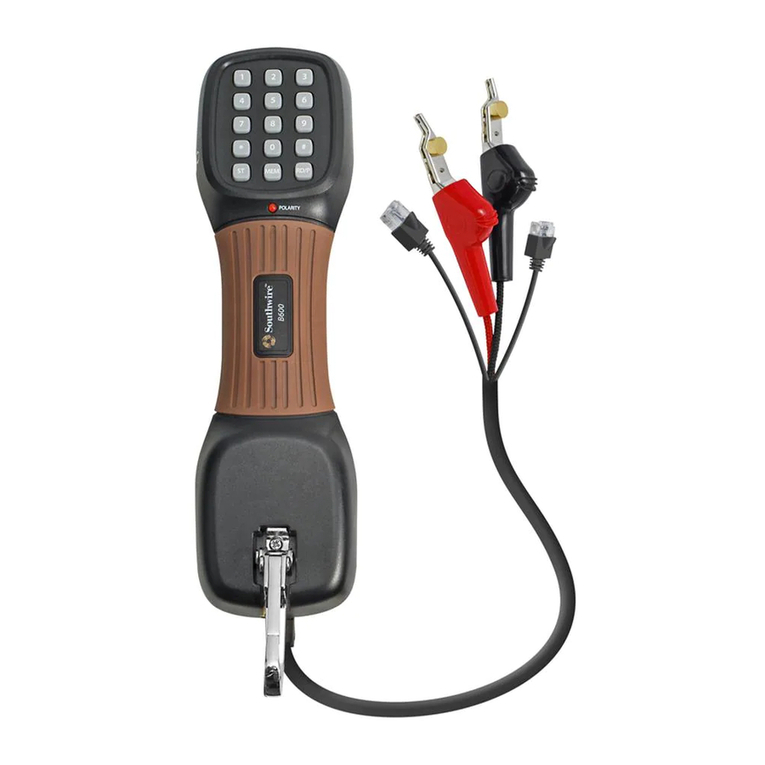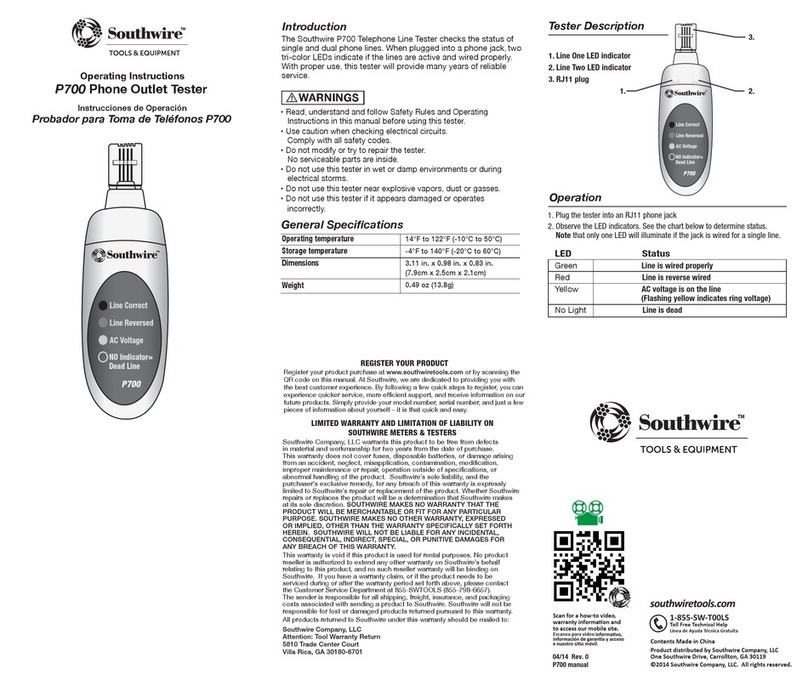5
Especificaciones
Pasos de LED de Voltaje
Precisión
Tiempo de respuesta
Rango de frecuencia AC
Tiempo de operación
Tiempo de recuperación
Protección de sobre voltaje
Rango de temperatura
Humedad Relativa
Altitude
Pollution Degree
Seguridad
12, 24, 48, 120, 208, 240V
-30% a 0% de indicación
<0.1s
50/60Hz
Máximo 30 segundos
10 minutos después de alcanzar el tiempo de operación máximo
250V AC/DC <5s
14° a 131°F (-10°C a 55°C)
80% máximo
7000ft (2000m)
II
Cumple con EN61010-1,
para el uso en ambientes del CAT III de la sobretensión
Prueba GFCI
1. Revise las instrucciones en el dispositivo GFCI específico que
va a chequear.
2. Presione el botón de prueba (test) en el receptáculo GFCI.
El GFCI se debe disparar. Si no, no utilice el receptáculo y
consulte a un electricista calificado. Si se dispara, presione
el botón “reset” en el receptáculo GFCI.
3. Inserte una sonda de prueba en el lado activo del tomacorriente
que se va a comprobar.
4. Inserte la otra sonda en la tierra del receptáculo que se va
a comprobar.
5. El voltímetro debe indicar 120VAC si el tomacorriente tiene corriente
y está cableado correctamente.
6. Presione el botón “test” en el GFCI.
7. Las luces indicadoras se apagarán para indicar que el interruptor se ha disparado.
8. Si el GFCI no se dispara, o el receptáculo está mal cableado o el GFCI está
defectuoso. No utilice el receptáculo y consulte a un electricista calificado.
Observe todas las precauciones de
seguridad al trabajar en voltajes activos. La función de prueba
GFCI solo se puede utilizar en receptáculos de 120 voltios AC
con protección GFCI (Interruptor de falla a tierra).
ADVERTENCIA:
Nota: El voltímetro no puede comprobar la operación de GFCI en tomacorrientes de
2 alambres (sin conexión a tierra).
Operación
6
REGISTRE SU PRODUCTO
Registre su producto en www.southwiretools.com o al escanear el código QR en
este manual. En Southwire, estamos dedicados a proveer la mejor experiencia al
cliente. Al seguir unos pasos rápidos para registrar su producto, usted puede recibir
un servicio más rápido, ayuda más efectiva, e información acerca de futuros
productos. Simplemente proporcione el número de modelo y serie de su producto,
y alguna información personal – es así de fácil y rápido.
GARANTÍA LIMITADA Y LIMITACIÓN DE RESPONSABILIDAD EN MEDIDORES Y
PROBADORES DE SOUTHWIRE
Southwire Company, LLC garantiza este producto contra defectos en materiales y
mano de obra por dos años desde de la fecha de compra. Esta garantía no cubre
fusibles, baterías desechables, ni daños como resultado de un accidente, negligencia,
mala aplicación, contaminación, modificación, mantenimiento o reparación indebida,
uso fuera de las especificaciones, o manipulación anormal del producto. La única
responsabilidad de Southwire, y el único remedio del comprador, por cualquier
incumplimiento de esta garantía está limitada expresamente a la reparación o
reemplazo del producto por parte de Southwire. La reparación o reemplazo del
producto se hará bajo la determinación de Southwire y a su discreción.
SOUTHWIRE NO GARANTIZA QUE ESTE PRODUCTO SERÁ COMERCIABLE O ADECUADO PARA ALGÚN
PROPÓSITO EN PARTICULAR. SOUTHWIRE NO HACE NINGUNA OTRA GARANTÍA, EXPRESA O IMPLÍCITA,
SALVO QUE LA GARANTÍA ESPECÍFICAMENTE MENCIONADA EN ESTE PÁRRAFO. SOUTHWIRE NO SERÁ
RESPONSABLE DE DAÑOS INCIDENTALES, CONSECUENCIALES, INDIRECTOS, ESPECIALES, O PUNITIVOS
POR CUALQUIER INCUMPLIMIENTO DE ESTA GARANTÍA. Esta garantía no será válida si el
producto se utiliza para propósitos de alquiler. Ningún vendedor de productos está
autorizado para extender la garantía a nombre de Southwire en relación a este
producto, y la garantía de ningún vendedor será vinculante para Southwire. Si necesita
reclamar una garantía, o si el producto necesita servicio durante o después del periodo
de garantía mencionado en este documento, por favor contacte a Servicio al Cliente al
855-SWTOOLS (855-798-6657) o visite www.southwiretools.com para obtener una
autorización para devolver (RA) el producto, en la página web, haga clic en “Service
Department” para pedir un número de RA).
Usted debe obtener un número RA de Southwire antes que Southwire pueda procesar
la reclamación de garantía o pueda hacer cualquier servicio. La persona que haga la
devolución será responsable de los costos de envío y seguro asociados con enviar un
producto a Southwire. Southwire no se responsabiliza por productos dañados o
perdidos durante la devolución relacionada a esta garantía.
Todos los productos que se devuelvan a Southwire bajo esta garantía se deben
enviar a:
Southwire Company, LLC
Attention: Tool Warranty Return
840 Old Bremen Road
Carrollton, GA 30117
































